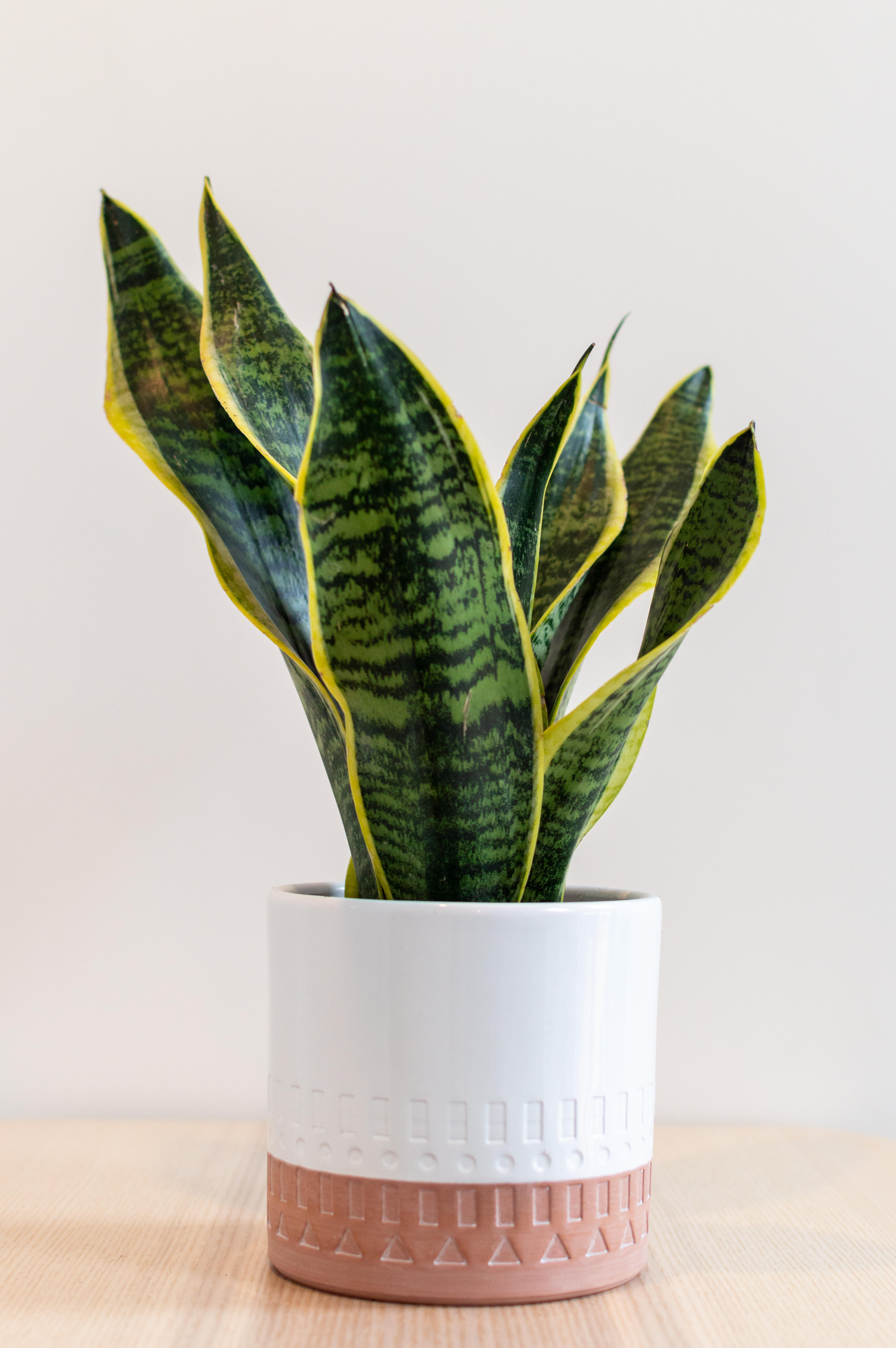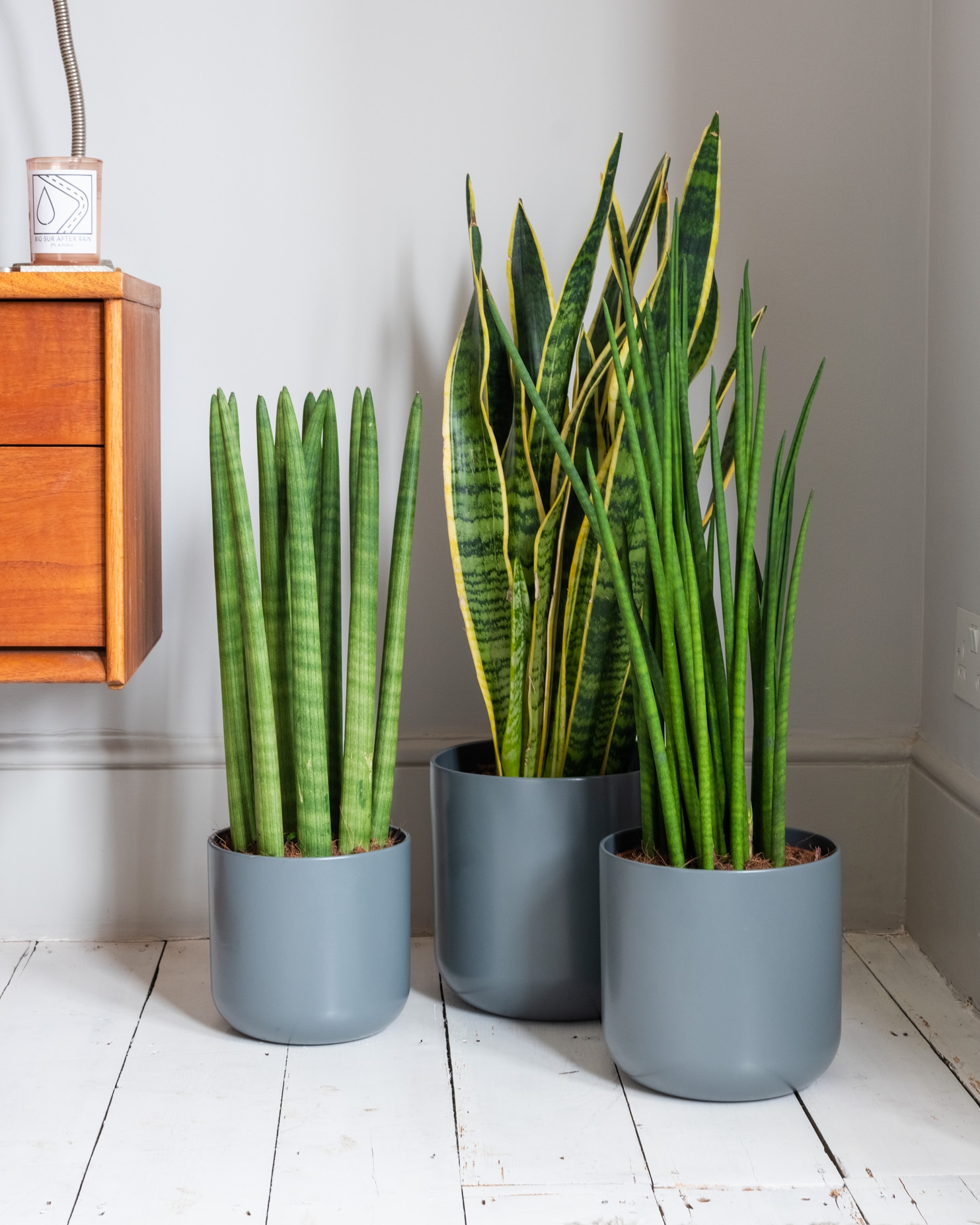How to care for a snake plant – 3 things every houseplant parent should know
Tall and sturdy, the snake plant makes a great addition to the home and is easy to look after


The snake plant is a 1970s classic, its pointed variegated leaves and yellow border being an iconic sight among rattan furniture and macrame wall hangings. Although we might associate it with a retro vibe, the snake plant - also known as Mother-in-Law's Tongue - makes a beautiful addition to a modern home with its unique shape and bursts of color.
Officially known as the Dracaena Trifasciata, the snake plant grows in clusters of stiff, hardy leaves which are dark green in color and banded with light green or silvery streaks. As a decorative houseplant, the variegated variety with its yellow border is the most common, and the lack of stem makes them a quirky feature in the home.
If you're not ready to be a full-time plant parent, the snake plant is one of the best houseplant for beginners as they're virtually indestructible. Their tall structure and architectural shape makes them a great plant to incorporate into your home as they're sure to catch the eye of any guest. Most snake plants are only around a foot tall so they work well on a shelf or a desk where their air purifying abilities will help to boost your productivity.
As Jo explains: 'The snake plant’s superpower has to be its incredible air-purifying abilities – so good, it was credited in NASA’s Clean Air Study for removing nasty toxins from your home. It’s a real VIP (Very Impressive Plant!)'
While they're usually shelf-friendly, the snake plant's leaves can grow up to eight feet tall, at which stage they make a great statement in the corner of a room, too.
How do you care for an indoor snake plant?
The evergreen perennial is native to tropical west African regions making it extremely drought tolerant, so it can handle a bit of neglect. It's also a very slow grower, so there's no need for pruning, propagating or repotting (in most cases). Here's what you need to know.
1. Dry is best
How often should you water a snake plant? The snake plant is extremely tolerant but if there's one thing it hates, it's over-watering. This sturdy houseplant will last for years if you offer it bright and dry conditions, but too much water will send it to its death bed in no time.
There's no ideal watering schedule for a Mother-in-Law's Tongue but as a rule of thumb, it's best to test the top inch of the soil. 'Snake plants don't need much water at all, so just give yours a drink every few weeks when the soil feels dry,' says Richard Cheshire, plant doctor at Patch Plants. 'This will be a bit more frequent in summer and larger plants will need more water as well as watering more often.'
Yellow or drooping leaves that are soft and squishy to the touch are a common sign of overwatering. 'Pour the water directly into the soil rather than over the leaves,' explains Jo of Beards & Daisies. 'The snake plant can be prone to root rot, so good drainage is essential. Make sure your plant has free-draining soil and keep it in a pot with drainage holes.'
It's safer to always err on the side of caution when it comes to watering. If in doubt, skip watering for another week - recovering from drought will be a lot easier than saving the plant from overwatering!
During the growing season, you might want to add a little plant feed to your watering regime to encourage growth. 'In spring and summer, the snake plant will benefit from being fed with a liquid plant fertilizer once per month,' explains Maddie Porritt, plant expert at The Stem.

2. Only repot when necessary
Because it's a slow grower, the snake plant gets pretty comfortable in its home so it won't enjoy being disturbed through regular repotting. The good thing is, it won't need to be repotted very often.
These hardy plants will be sure to let you know when they do want a more roomy home, however. 'If the roots are bursting out of the nursery pot, it's time to repot,' says Richard. 'Almost fill a slightly bigger new nursery pot (about 1-2 inches larger) with fresh compost. Gently squeeze the existing nursery pot to loosen the soil and remove the plant, dusting off any loose soil and checking the roots.' Be careful not to break any roots though as this won't make the plant happy.
'Then, simply put the plant into its new home, top it up with some more compost and give it a good water,' Richard continues. 'It's always best to repot in spring or summer if you can, as this is when your plant is in its growing phase.'

3. Keep out of direct sunlight
When it comes to lighting, the snake plant is very versatile. They're some of the best houseplants for low light, but growth will be slower since the baby plants closer to the soil won't receive enough light.
Ideally, bright and indirect light is best. A Mother-in-Law's tongue will enjoy a couple of hours of direct sun to encourage growth, but too much light will burn the leaves, especially when combined with heat. As Maddie explains, 'To see them at their best they like to be kept in a bright spot out of direct sunlight, but they can also survive in darker areas of the home.'
It might sound like a dangerous balancing act, but these wonderful plants are very resilient. 'Really, don’t sweat it too hard,' says Richard. 'Your snake plant will adapt to whatever light life sheds on them.'
For a bit of extra TLC, Richard suggests wiping your snake plant's leaves with a damp cloth every once in a while. 'This will remove any build-up of dust and help you plant to breathe freely, absorb light and look fabulous.'
What room is a snake plant best suited for?
The snake plant is regarded as a Feng Shui plant. As Jo explains, this makes it a great addition to the home office: 'according to Feng Shui, it absorbs negative energy and helps improve concentration levels and productivity!'
Due to its air purifying abilities, it also makes the perfect bedroom plant as it removes toxins such as formaldehyde and benzene from the home. 'It will store oxygen throughout the day and then release it back into the atmosphere at night, ensuring your breathing good quality air to aid a restful night’s sleep,' explains Jo.
Be The First To Know
The Livingetc newsletters are your inside source for what’s shaping interiors now - and what’s next. Discover trend forecasts, smart style ideas, and curated shopping inspiration that brings design to life. Subscribe today and stay ahead of the curve.

Lilith Hudson is a freelance writer and regular contributor to Livingetc. She holds an MA in Magazine Journalism from City, University of London, and has written for various titles including Homes & Gardens, House Beautiful, Advnture, the Saturday Times Magazine, Evening Standard, DJ Mag, Metro, and The Simple Things Magazine.
Prior to going freelance, Lilith was the News and Trends Editor at Livingetc. It was a role that helped her develop a keen eye for spotting all the latest micro-trends, interior hacks, and viral decor must-haves you need in your home. With a constant ear to the ground on the design scene, she's ahead of the curve when it comes to the latest color that's sweeping interiors or the hot new style to decorate our homes.
-
 Turns Out the Coolest New Café is Actually In Your Kitchen — Here's How to Steal the Style of TikTok's Latest Trend
Turns Out the Coolest New Café is Actually In Your Kitchen — Here's How to Steal the Style of TikTok's Latest TrendGoodbye, over-priced lattes. Hello, home-brewed coffee with friends. TikTok's 'Home Cafe' trend brings stylish cafe culture into the comfort of your own home
By Devin Toolen Published
-
 5 Bathroom Layouts That Look Dated in 2025 — Plus the Alternatives Designers Use Instead for a More Contemporary Space
5 Bathroom Layouts That Look Dated in 2025 — Plus the Alternatives Designers Use Instead for a More Contemporary SpaceFor a bathroom that feels in line with the times, avoid these layouts and be more intentional with the placement and positioning of your features and fixtures
By Lilith Hudson Published